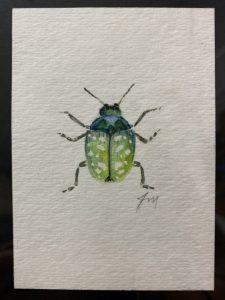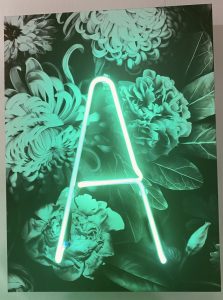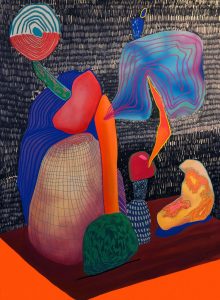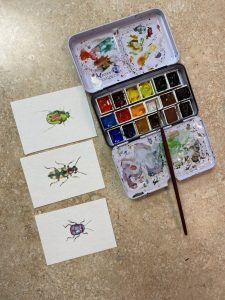by Beatrix Boehner
Pace Academy has an incredible visual arts program. We experience this though Arts Laureates, student work in galleries around the school, and the faculty exhibition that coincides with Spring Arts Week. This is a chance for students to appreciate artwork that their teachers create.

This year we had three teachers represent the Middle School in the Faculty Art Show: Katy Cowles, Anna Murphy, and Carla Contreras. Ms. Cowles exhibited three pieces inspired by a class she took on pumping and bending neon signs. Mrs. Murphy displayed several playful watercolor paintings of beetles. Mrs. Contreras presented three large scale mixed media paintings inspired by issues of urbanization and homelessness.

When writing this article, I was lucky enough to get the opportunity to interview these artists to learn about their inspiration, process, and overall perspective on art. These interviews highlighted similarities and differences across their work and raised reflections about the nature of art.
Looking across all of these pieces, there were a couple of similarities that all stood out. The most obvious was their use of color. The vibrant materials they used helped draw viewers in, and were pleasing to the eye, even before someone understood what exactly it was. They all drew the observer in, and made it so they wanted to learn more. It is obvious that these pieces aren’t just something that you would pass by, but rather something that you would study and find new things to enjoy about them the more you observed.

Another similarity is something that occurred in their work process. They all used layers to create their pieces. Mrs. Murphy layered watercolor patterns on top of each other to create intricate designs, and Ms. Cowles and Mrs. Contreras tackled the challenge of layering different media on top of each other, and finding a way to bring it all together. In the interview, when asked about their art process, and whether or not they start out with a clear idea of what they are trying to make, they all answered similarly. They mentioned that while they have an idea of how they want their piece to look, part of the process of art is just letting your hand take over, and creating things that may surprise you.
While these pieces shared some similar characteristics, their differences stood out more. The overall process, and the finished products of all of these artworks has a very special story behind it, and a unique approach to creating it.

One huge difference is the inspiration and the story behind creating these pieces. They all had completely different sources of motivation. Mrs. Contreras’s inspiration came from an extremely important social issue that is hard to talk about. Her hope was that this piece would get people talking about homelessness and urban issues. Mrs. Murphy was excited about creating a piece that would be fun to make and see come alive. “I had such a good time giggling about their little lives.” She ultimately created a little imaginary world with the beetles. Ms. Cowles was driven to learn new art practices, and that is where she got the idea for her pieces. “I was inspired to make simple shapes because I was new to neon art, and wanted to mount them in an untraditional way to see how neon can communicate differently especially on surfaces with different sheens.”

This is related to another difference: how they chose the piece they wanted to exhibit. Ms. Cowles likes to choose her favorite pieces of what she’s been working on that year. For her, the Faculty Art Show is a chance for her to push herself and try new things. Mrs. Murphy chose the pieces that brought her joy and would bring other people joy when they saw it. She thought a lot about the audience she wanted to reach, and wanted to create something to make them smile. Mrs. Contreras chose her piece based off of what she believed would engage discussions about important topics. When asked about sharing her work she said, “I get very excited to talk about the issues and concepts behind my work because I believe that art should communicate something, should challenge, and trigger, and create conversation. I love to listen to what the viewer gets from my work and what is his/her opinion or thoughts about the issues I tackle.”

Looking across the similarities and differences and through our overall discussion, it became apparent that art is multifaceted and just as varied as the artists who make it. There are many ways to approach art – as a provocation, as a conversation, as an exploration, and as a playful escape. We are lucky enough to have teachers at Pace Academy who explore art in so many ways and challenge their students to experiment with their own voice.
